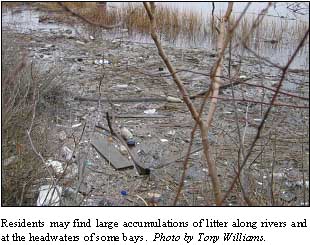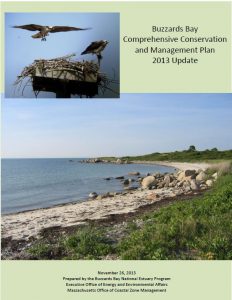2013 CCMP, Action Plan 14:
Reducing Beach Debris, Marine Floatables, and Litter in Wetlands
About the new Buzzards Bay CCMP Action Plans
The Buzzards Bay Comprehensive Conservation and Management Plan (CCMP) was updated in November 2013 to reflect the great progress achieved since the original CCMP was finalized. You can download the entire document (buzzards-bay-ccmp-2013-update.pdf) or just this action plan Reducing Beach Debris and Litter.

Reducing Beach Debris, Marine Floatables, and Litter in Wetlands
Problem
Each year, thousands of residents and visitors enjoy Buzzards Bay for boating, swimming, fishing, hiking, and birding. Many also visit the extensive inland wetlands, waterways, and open space throughout the watershed. Increasingly, litter, marine debris, and disposal of hazardous and non-hazardous waste have degraded these areas. Litter and debris may be conveyed by stormwater systems (Figure 94), and debris can wash ashore with tide (Figure 95). Although litter and debris in wetlands and the marine environment may seem to be a less serious problem than some others facing Buzzards Bay, it is in fact a problem that cuts across many action plans, and contributes to the ever growing garbage patches appearing in ocean gyres, consisting of fine plastic particles and other materials. Litter collection also involves residents and visitors in assuming responsibility and ownership of open space and wetlands they use.
Goal
Goal 14.1 To ensure that Buzzards Bay beaches, coastal waters, and inland wetlands habitat are clear of harmful and degrading levels of marine debris.
Objectives
Objective 14.1. Ensure an adequate number and capacity of waste disposal barrels be provided at public beaches and public and private marinas, and boat haul-outs.
Objective 14.2. Stormwater discharge BMPs should include strategies to reduce or eliminate discharges of debris and floatables.
Objective 14.3. Encourage fishermen to not dispose of fishing lines, nets, cables, and trash at sea or on shore.
Objective 14.4. Educate the public and businesses on the importance of reducing litter and marine debris discharges and involve them in the potential solutions.
Objective 14.5. Ensure that state and local officials work in concert to reduce litter on public lands, beach debris, and marine floatables.
Objective 14.6. Identify and map important debris location sites, natural collection points, and potential remediation strategies.
Approaches
Reducing litter and trash in the environment is complex; it will require better education of the public, prop-erty owners, and businesses, and improved collaboration of local government with neighborhood associations, and non-profit organizations. Implementation of this management plan involves three core strategies: undertaking periodic cleanups, implementing litter preventions programs to ensure both proper trash disposal and encourage waste reduction, and adopting any needed laws and regulations to increase awareness and accountability of litter generators. Government can also set an example in purchasing programs to focus on biodegradables and items less likely to enter litter waste streams.
Costs and Financing
The costs to implement this action plan are nominal; and the focus is to encourage individuals and businesses to take responsibility for the problem, and encourage volunteerism to solve the problem. There are some costs associated with cleanups, expendable supplies, signage, trash removal, and staff time, but some of these costs can be met through adopt a road or wetland programs with businesses and non-profit organizations.
Measuring Success
Measuring success in this action plan is difficult be-cause the amount of litter collected is a function of collection effort. Assessments that are more complex could include evaluations of extent of littering; however, programmatic achievements might be easier to track. These could include extent of areas adopted for cleanup; length of beaches cleaned each year, and the number of cleanup events held.
